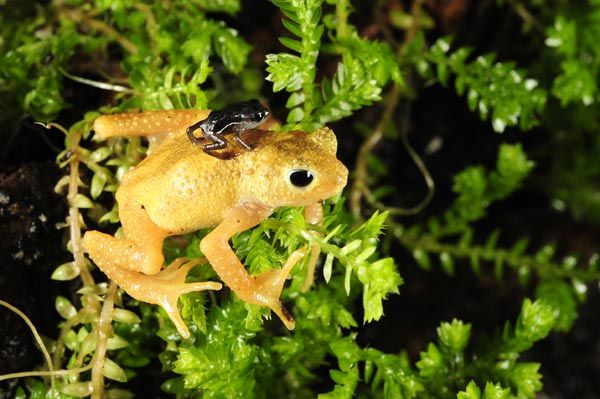
Rare, Endangered Toads Flown Back to Native Habitat

One hundred of the rarest amphibians on the planet have been flown to Tanzania in an effort to reintroduce the tiny amphibians into their former habitat.
The Kihansi spray toads (KST), last seen in the wild in 2004, were raised at the Bronx Zoo in New York and The Toledo Zoo in Ohio now reside at a new, state-of the-art propagation center in Dar es Salaam, Tanzania's commercial capital.
"On behalf of the Government of the United Republic of Tanzania, weare very grateful to the Bronx Zoo and The Toledo Zoo for taking care of these precious toads (KST) for 10 years, and now they have safely arrived home via KLM flight and all 100 toads are cheerful as witnessed by our Tanzanian trained KST keepers at the facility at UDSM Zoology Department. We are very optimistic that they will acclimatize soon and be taken to their homeland in Kihansi Gorge in the near future," said Anna Maembe on behalf of the Government of Tanzania.
The Kihansi spray toad's unique odyssey began shortly after the species was first discovered in 1996 living in a 5-acre micro-habitat created by the spray of nearby waterfalls in the Kihansi Gorge.
In 1999, the construction of a hydroelectric dam in the gorge dramatically changed the Kihansi spray toad's habitat. Although this dam is vital to the Tanzanian economy in that it generates one-third of Tanzania's total electrical supply, its construction reduced the original size of the Kihansi falls to 10 percent of its former flow, drastically lessening the mist zone in which the toads thrived.
Following an agreement between the Wildlife Conservation Society and the Tanzanian government and with funding from the World Bank, which constructed the dam, scientists and Tanzanian officials collected an assurance colony of 499 Kihansi spray toads from the gorge.
The toad was last seen in the wild in 2004, and in 2009 the toad was declared to be extinct in the wild by the International Union for the Conservation of Nature (IUCN).
Sign up for the Live Science daily newsletter now
Get the world’s most fascinating discoveries delivered straight to your inbox.
Today, 5,000 toads live at The Toledo Zoo and 1,500 reside at the Bronx Zoo. Both zoos will continue breeding and exhibiting the animals, returning additional shipments to Tanzania as their numbers rebound.
"For years, the Bronx Zoo has been anticipating this important step toward reintroduction of the species, and we are ecstatic that the first toads are thriving in the new facility," said Jim Breheny, director of the Bronx Zoo and Wildlife Conservation Society Senior Vice President of Living Institutions.
The Tanzanian government has been managing the Lower Kihansi Environment Management Project in the gorge. A system of sprinklers, replicating the toad's habitat, has been installed in preparation for the species' return. The ultimate goal is to return the toads to their natural habitat within the gorge.
Scientists are still debating the ultimate cause of extinction of this species in the wild, but theorize a combination of habitat change, pesticide exposure and the emergence of infective chytrid fungus led to their demise. Chytrid is responsible for alarming crashes and extinctions of amphibian species in many parts of the world.
A species unusual among toads, KST females give birth to live, fully-formed young, rather than laying eggs that hatch into free-living tadpoles.
- Images: Top 10 Lost Amphibians
- 10 Species You Can Kiss Goodbye
- Images: Endangered and Threatened Wildlife
This article was provided by OurAmazingPlanet, a sister site to LiveScien











